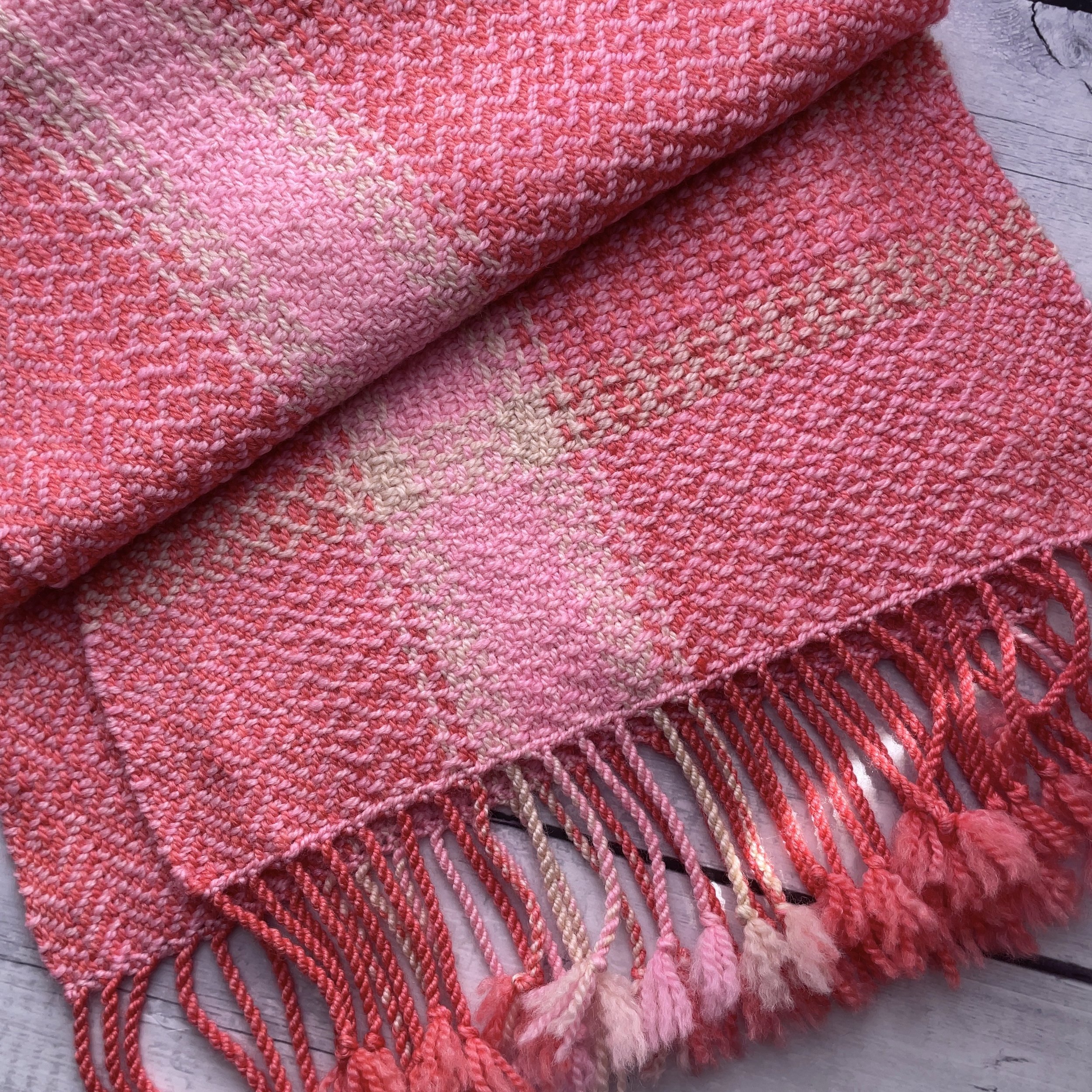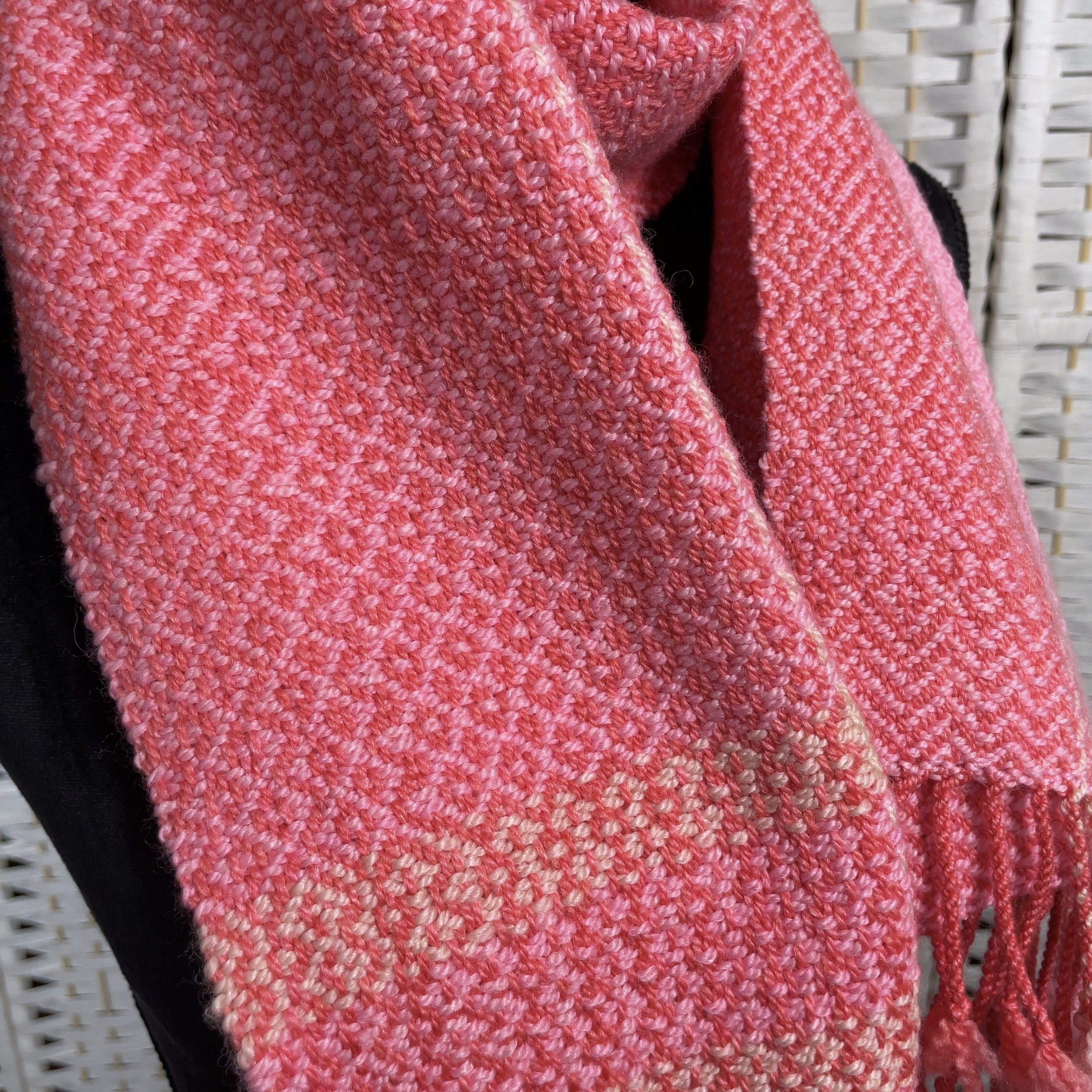A woven scarf and some thoughts on bamboo fibre
First, let’s do the show and tell… I wove this scarf on my Baby Wolf on 4 shafts. The threading is a combination of broken twill and wall of troy, the tie up is a straight 2/2 twill tie up, and the treadling is also a combination. The yarn I used was a fingering yarn in a blend of merino and bamboo, I’ve had this in my stash for many years and I dyed the colours myself. The yarn is very soft and bouncy, it is probably more suited to knitting/crochet than weaving, but I wanted to use it for this project so there it is.
A handwoven scarf in 2/2 twill
I went a little free range in treadling ;)
Project info:
Warp ends: 168 + 2 floating selvedges
Warp length: 250 cm
Loom width: 35.5 cm
Sett: 12 epi
Finished measurements: 155cm x 30cm excluding fringes
The finished scarf is incredibly soft and squishy, I could snuggle up to it all day long - but here is the dilemma, the yarn is a merino/bamboo blend and bamboo is problematic.
In recent years bamboo fibre has been promoted as the “natural wonder fibre” because of it’s breathiness, soft handle and its anti-odour properties. But I have been reading/hearing about the nastiness associated with it, this is nothing against the bamboo itself, rather, it is the process that makes bamboo into fibre that’s problematic. I’ve often been asked if I stocked bamboo fibre or if I had anything with bamboo in it, the answer had been “no” ever since I found out how the fibre was made. But sometimes the conversation demanded more than a simple “no”, so I thought I’d put together some information in regard to the manufacturing process. There are tons of information on the internet on this topic and this post is by no means in-depth nor extensive, it simply offers a springboard should you wish to delve into it more yourself.
So how is bamboo fibre made? There are two methods essentially: chemically or mechanically. Without going into too much detail here’s some low down in easier to understand terms …
The good - mechanically produced bamboo fibres, also known as bamboo linen, is a better way to make bamboo fibres in that the bamboo plant is physically crushed by machines then natural enzymes are added to make it into a mush so that fibres can be extracted and spun into yarn. Because this method does not use nasty chemicals it takes more time and effort, so the production cost is very high and you will probably only see this in high end/luxury linens.
The not as bad - another method is the closed loop production where, although it still requires the use of chemical solvents to dissolve the bamboo plant, the solvents are circulated back into production and can be used again and agin.
The ugly - most of the bamboo fibres (fibres, yarn, fabric) on the market is produced in this way, where harmful chemicals such as caustic soda, carbon disulfide and sulfuric acid are used to extract cellulose from the bamboo plant and turn it into viscose, also known as rayon. These are extremely toxic chemicals that are not only bad for the environment they are also harmful to the workers who have to work with them. And because the properties of bamboo have been so drastically altered by the chemicals there’s hardly any “natural” component left and it will not compost.
Unfortunately for us consumers it is very difficult to discern where the bamboo fibres come from and how they are produced. Even with an organic certification it does not certify the actual manufacturing process. As for the bamboo rayon or bamboo viscose (the ugly), it is probably the biggest greenwashing in recent fashion history.
So for this reason I will not buy/stock any more bamboo fibres, but it seems wasteful to just throw out what I already have which is why I will find ways to use it up, hopefully I will make it into something that will last a long time thus prolonging the inevitability of it eventually ending up in the landfill.
I’m listing some of the resources concerning this topic so you can check them out if you so wish. And if you have information that I’ve missed please let me know.
p.s. Rayon/viscose fabric is just as bad, the process is the same as that listed in “the ugly”.
Resources:
Book: Fake Silk, the Lethal History of Viscose Rayon, by Paul David Blanc, published 2016
Book: Detox Fashion, case studies, editor Subramanian Senthikannan Muthu
Online article: Bamboozled? Getting the facts on bamboo textiles
Online article: What is Bamboo Fabric and Is It Sustainable?
Online article: Greenwashing Alert: Rayon Viscose Is Made From Plants, but Is Also Toxic and Destructive
Online article: Is Bamboo Fabric Sustainable? Or Greenwashing?




